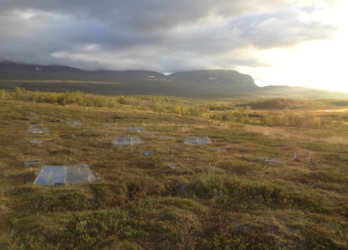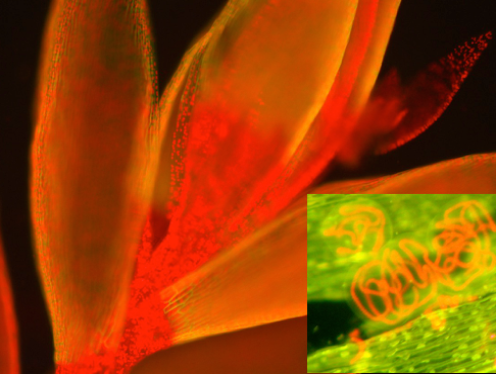Field experiment in tundra vegetation in Northern Sweden. Open top chambers simulate future warming of soil and plants caused by climate change, and leaf litter is added to simulate enhanced litterfall caused by expansion of birch trees and willow shrubs (Photo: Anders Michelsen)
In northern Scandinavia, shrubs expand into the tundra, where fixation of nitrogen from the air is mostly performed by cyanobacteria associated with mosses. Additionally, enhanced nitrogen fixation stimulates plant growth. New research shows that as taller shrubs expand into the tundra, nutrients in leaf litter will either promote or reduce nitrogen fixation, depending upon which shrub species dominates. The scientific results have recently been shown by scientists Kathrin Rousk and Anders Michelsen from Center for Permafrost and Department of Biology at University of Copenhagen, and is now published in Global Change Biology.
Mosses in subarctic tundra are colonized by bacteria that fix atmospheric nitrogen (N2), and together, they can contribute 50 percent to total ecosystem nitrogen input. Despite this key role, the effects of climate warming and increased litter input as a result of shrub expansion on N2 fixation in mosses are ambiguous.
Assistant Professor Kathrin Rousk of the Department of Biology explains, "To aid in predicting the role of moss-associated N2 fixation in a warm future climate, we quantified N2 fixation throughout the snow-free period in subarctic tundra. We used data from a field experiment in northern Sweden, in which climate change was simulated with open-top chambers to increase the air and soil temperature, and with the addition of plant litter from willow and birch-shrubs."
The results show that N2 fixation was highest in the warmed chambers and in the birch litter addition plots (around 3 kg N ha-1 yr-1), while the willow litter additions led to decreased N2 fixation rates (less than 2 kg N ha-1 yr-1).
Micrograph of moss leaves with insert micrograph of a chain of blue-green algae (cyanobacteria) (red) on a c. 0.1 mm long fragment of a moss leaf (green). The micrographs of the cyanobacteria, which fix free N2 from the air, are taken in a fluorescence microscope with a green filter (200x magnification). Micrographs by Kathrin Rousk
Rousk says, "Warming will lead to increased N2 fixation rates in mosses, while the consequences of further shrub expansion will depend on the dominant shrub invading—the expansion of willow will likely limit the nitrogen input via N2 fixation, whereas a predominance of birch shrubs will increase N2 fixation and with that, nitrogen supply to the ecosystem."
The amount of N2 that is fixed is important because nitrogen is an essential nutrient for plant growth and is available only in limited supply in arctic ecosystems. Nitrogen availability influences how much CO2 plants are able to acquire through photosynthesis, and hence it impacts the carbon balance. Changes in N2 fixation due to global warming will alter nitrogen input to arctic ecosystems with significant consequences for plant growth.
Journal information: Global Change Biology
Provided by University of Copenhagen





















